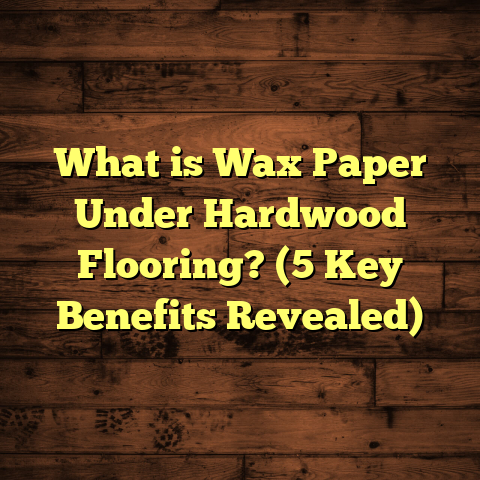What is Vinyl Flooring? (5 Key Benefits for Your Home)
When I think about the best flooring options for a home, vinyl flooring consistently comes to mind. It’s one of those materials that strikes the right balance between style, durability, affordability, and practicality. Over many years working on numerous flooring projects—from kitchens to basements—I’ve seen firsthand how vinyl can transform a space without breaking the bank. I want to take you through what vinyl flooring really is, how it’s made, and why it might just be the best choice for your home.
What Is Vinyl Flooring?
Let’s start with the basics: What exactly is vinyl flooring? At its core, vinyl flooring is a synthetic product made primarily of polyvinyl chloride (PVC) resin. PVC is a type of plastic that has been engineered to be flexible yet durable, making it ideal for floor coverings.
Vinyl flooring is designed to imitate natural surfaces like hardwood floors, stone tiles, slate, or ceramic without the cost or maintenance headaches that come with those materials.
Types of Vinyl Flooring
There are several types of vinyl flooring that I encounter in my work:
- Sheet Vinyl: This comes in large continuous sheets that can be rolled out to cover an entire floor with very few seams. It’s great for wet areas like bathrooms or laundry rooms because seams can be minimized or sealed.
- Vinyl Composition Tile (VCT): These are small square tiles often used in commercial spaces. They’re durable but usually require regular waxing and maintenance.
- Luxury Vinyl Tile (LVT) and Luxury Vinyl Plank (LVP): These are the more upscale vinyl products designed to closely mimic wood planks or stone tiles. They often have realistic textures and high-quality finishes.
Manufacturing Process and Technical Specifications
Understanding how vinyl flooring is made gives me a greater appreciation for its performance.
Vinyl flooring typically consists of layered components fused together by heat and pressure:
- Backing Layer: Usually made from fiberglass or felt for dimensional stability and flexibility.
- Core Layer: Made of PVC or composite materials that provide structure and durability.
- Design Layer: A high-resolution printed image of wood grain, stone veining, or tile patterns.
- Wear Layer: A transparent topcoat that protects the design from stains, scratches, and wear.
The wear layer thickness varies widely. Thicker wear layers mean better protection and longer life:
| Wear Layer Thickness | Typical Use | Durability |
|---|---|---|
| 6-12 mil (0.15-0.3 mm) | Residential light use | 5-10 years |
| 12-20 mil (0.3-0.5 mm) | Residential moderate use | 10-15 years |
| 20-30 mil (0.5-0.75 mm) | Commercial heavy use | 15+ years |
The wear layer is typically made of urethane with added aluminum oxide for scratch resistance. The thicker this layer, the better the floor handles scratches, dents, and stains.
Vinyl floors also meet specific standards for abrasion resistance—for example, ASTM D4060 testing using the Taber Abrasion method rates many luxury vinyl products as Class 3 or Class 4 abrasion resistance, meaning they stand up well under heavy foot traffic.
Additional Technical Specs
Here are some key specs to keep in mind:
- Total Thickness: Usually ranges from 2 mm (sheet vinyl) up to 8 mm (luxury vinyl planks).
- Water Resistance: 100% waterproof because PVC does not absorb moisture.
- Indentation Resistance: Good resilience against dents from furniture or heels.
- Fire Rating: Many vinyl floors meet Class C or better fire ratings.
- VOC Emissions: Many modern vinyl floors are low-VOC certified (FloorScore or GREENGUARD) for indoor air quality.
When I’m helping homeowners select flooring, these details matter a lot because they influence how long the floor lasts, how it performs under stress, and the overall comfort.
Why Vinyl Flooring Stands Out: My Top 5 Benefits for Your Home
I’ve installed all kinds of flooring materials over the years—hardwood, laminate, tile, carpet—but vinyl keeps coming back as one of my favorites for many reasons. Here are five key benefits I’ve seen again and again on job sites and in real homes.
1. Design Flexibility That Matches Any Style
One thing I love about vinyl flooring is its incredible versatility in design.
Have you ever wanted the look of exotic hardwood but couldn’t justify the price or maintenance? Vinyl can replicate almost any natural look you want—from rustic oak to smooth marble—complete with realistic texture you can feel underfoot.
In one project a few years ago, a client wanted the warm feel of whitewashed oak but had two energetic kids and a modest budget. We went with luxury vinyl planks that perfectly matched the look without worrying about scratches or water damage. Years later, the floor still looks fantastic.
Manufacturers now use high-resolution digital printing combined with embossing techniques to create detailed patterns that fool even trained eyes—without the price tag or upkeep of natural materials.
Color and Pattern Options
Vinyl comes in hundreds of colors and patterns:
- Wood grains mimicking oak, maple, walnut, hickory.
- Stone patterns like granite, travertine, slate.
- Abstract or geometric designs for modern looks.
- Solid colors and textures for minimalist spaces.
This variety means you can customize your home’s vibe exactly how you want it.
2. Durability That Holds Up Over Time
One question I often get is: “Will vinyl flooring last?” Based on my experience and data from manufacturers:
- Vinyl floors typically last 10 to 20 years depending on quality and use.
- Luxury vinyl with thicker wear layers offers excellent protection against scratches, dents, and stains.
- Vinyl resists fading from sunlight better than many laminate floors.
In homes with pets or kids running around, I’ve seen vinyl floors maintain their appearance where hardwood would show scratches and carpet would stain.
Case Study: A Busy Family Kitchen
I worked on a project where a family chose LVT for their kitchen and hallway—areas that see daily heavy foot traffic plus occasional spills. After 12 years, their floor looked almost new except for minor scuffs easily buffed out. The durability was impressive compared to their friend’s hardwood floor showing wear after just five years.
This durability makes vinyl a practical choice if you want a long-lasting floor without constant repairs.
3. Water Resistance Makes It Perfect for Wet Rooms
What I appreciate most about vinyl is its 100% waterproof nature. Unlike hardwood or laminate that can warp or swell when exposed to moisture, vinyl doesn’t absorb water.
This feature alone makes vinyl my go-to recommendation for kitchens, bathrooms, basements, mudrooms—anywhere moisture is a concern.
For example, I installed sheet vinyl in a basement prone to minor flooding due to heavy rains. The floor never bubbled or buckled even after water seeped under the edges during storms.
Waterproof vs Water-Resistant
People sometimes confuse water-resistant with waterproof:
- Water-resistant means it can handle some moisture but may get damaged if water pools.
- Waterproof means no water absorption at all; vinyl floors fall into this category.
Knowing this distinction helps homeowners avoid costly mistakes.
4. Simple Maintenance Saves You Time and Money
I’m all about making life easier for homeowners. Vinyl floors require very little care:
- Regular sweeping or vacuuming to remove dirt.
- Occasional damp mopping with mild cleaners.
- No waxing needed like some tile or VCT floors.
- No refinishing like hardwood.
In my experience managing properties with busy tenants or families, floors that are easy to clean stay in better shape longer.
Data on Cleaning Time
Studies show people spend about 50% less time cleaning vinyl floors annually than carpet or hardwood floors because spills wipe up easily and there’s no dust trapping fibers.
I know several clients who switched from carpet to vinyl in kids’ playrooms because it was so much easier to keep clean from snacks and spills.
5. Cost Efficiency Without Sacrificing Quality
Budget plays a major role in choosing flooring. Vinyl offers great value:
- Material costs range from $2 to $7 per square foot depending on quality.
- Installation costs vary but tend to be lower than hardwood or natural stone.
When planning projects, I always factor in total cost including materials, labor, waste factor, and prep work. Tools like FloorTally have become invaluable here—they let me calculate accurate project costs based on local prices and labor rates quickly.
Using FloorTally saves me from juggling multiple quotes or guessing waste percentages. It provides a detailed breakdown so I can set realistic budgets upfront—a huge relief for clients avoiding surprise expenses.
Digging Deeper: Technical Insights & Personal Stories
How Thickness Impacts Comfort & Sound
Vinyl flooring comes in various thicknesses—from thin sheet vinyl at around 2 mm to luxury planks up to 8 mm thick. Thickness affects:
- Comfort: Thicker vinyl feels softer underfoot.
- Sound absorption: Thicker floors reduce footsteps noise better.
- Durability: More material often means better wear resistance.
In one condo installation I did with an attached foam underlayment under LVP planks (total thickness ~6 mm), tenants were amazed at how quiet their footsteps became compared to tile floors upstairs.
Installation Methods I’ve Worked With
There are two main installation types:
Glue-down Installation
This method uses adhesive applied directly onto the subfloor before laying the vinyl. It creates a very secure bond but requires more prep work and drying time.
I usually recommend glue-down in commercial settings or high-traffic residential areas where maximum durability is needed.
Click-Lock Floating Floors
Click-lock systems snap planks together without glue. They’re easier and faster to install and allow replacing damaged planks individually.
For DIYers or quick home renovations, click-lock floors are my go-to recommendation because you don’t need special tools or adhesives.
Environmental Impact & Indoor Air Quality
PVC-based products sometimes get a bad rap for environmental reasons. However:
- Many manufacturers now produce low-VOC vinyl flooring certified by programs like FloorScore or GREENGUARD.
- Some brands incorporate recycled content into their products reducing raw material use.
If indoor air quality matters to you or you have allergy concerns, ask for these certifications when choosing a product.
More Data & Case Studies That Back Up Vinyl Flooring’s Strengths
Longevity vs Other Floors
| Flooring Type | Average Lifespan | Maintenance Needs |
|---|---|---|
| Hardwood | 20-30 years | Refinishing every 7-10 years |
| Laminate | 10-15 years | Minimal |
| Carpet | 5-8 years | Deep cleaning frequently |
| Vinyl | 10-20 years | Simple sweeping/mopping |
Vinyl stands out as an affordable option with solid longevity and minimal upkeep compared to carpet or laminate.
User Satisfaction Survey Insights
A flooring industry survey found:
- Over 80% of homeowners who installed luxury vinyl were satisfied with its performance after five years.
- Homeowners cited ease of cleaning (72%) and durability (68%) as top advantages.
This matches what I hear regularly from my clients.
Common Questions I Get About Vinyl Flooring
Q: Can I install vinyl over existing floors?
A: Often yes—vinyl can be installed over clean, smooth surfaces like concrete or plywood. However, uneven subfloors may require leveling first.
Q: Does vinyl fade in sunlight?
A: Quality luxury vinyl has UV inhibitors that resist fading better than laminate but prolonged direct sun exposure can cause slight color changes over many years.
Q: Is vinyl cold underfoot?
A: It can be cooler than carpet but warmer than tile. Adding underlayment improves comfort and insulation.
Final Thoughts From My Years of Flooring Experience
Vinyl flooring has earned its spot as one of my favorite choices due to its unbeatable combo of style options, durability, water resistance, ease of maintenance, and affordability.
Whether you want a quick kitchen makeover or need tough basement flooring that won’t warp or stain—vinyl delivers results that stand the test of time without hassle.
If you want help estimating costs accurately based on your local market conditions, tools like FloorTally make planning painless by providing detailed budget breakdowns tailored to your project specifics—something I personally rely on every time I take on a new job.
Have you thought about installing vinyl flooring? Maybe you already have? I’d love to hear about your experience—the good, the challenges—and any tips you might have picked up along the way!
If you want me to expand any section further or add more technical details like chemical composition specifics or environmental impact comparisons with other materials, just let me know!





